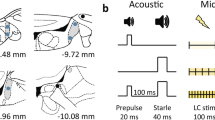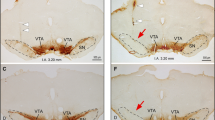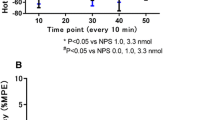Abstract
The effects of different doses (0.03, 0.06, 0.12, 0.25, 1.0, 2.0, 4.0, and 8.0 mg/kg body weight) of 5-methoxy-N,N-dimethyltryptamine (5-MeODMT) were tested on the acoustic startle reflex in rats. Beginning at 0.12 mg/kg, 5-MeODMT increased startle monotonically up to the highest dose used. 5-MeODMT still increased startle in acutely decerebrate rats or when infused directly onto the spinal cord. The excitatory effects of a high systemic dose of 5-MeODMT were completely blocked by cinanserin, cyproheptadine, and propranolol, but not by parachlorophenylalanine, α-methyl-p-tyrosine, haloperidol, sotalol, or phenoxybenzamine. The results were discussed in terms of a new theory, which suggests that stimulation of serotonin receptors in the spinal cord enhance startle whereas serotonin receptors in the forebrain inhibit startle.
Similar content being viewed by others
References
Anden NE, Jukes MGM, Lundberg A (1964) Spinal reflexes and monoamine liberation. Nature 202:1222–1223
Carlton PL, Advokat C (1973) Attenuated habituation due to parachlorophenylalanine. Pharmacol Biochem Behav 1:657–663
Chadwick D, Hallett M, Jenner P, Marsden CD (1978) 5-Hydroxytryptophan-induced myolonus in guinea pigs: A physiological and pharmacological investigation. J Neurol Sci 35:157–165
Conner BL, Stolk JM, Barchas JD, Levine S (1970) Parachlophenylalanine and habituation to repetitive auditory startle stimuli in rats. Physiol Behav 5:1215–1219
Davis M, Aghajanian GK (1976) Effects of apomorphine and haloperidol on the acoustic startle response in rats. Psychopharmacology 47:217–223
Davis M, Astrachan DI, Kass E (1980) Serotonin: Excitatory and inhibitory effects on behavioral reactivity measured with acoustic startle. Science 209:521–523
Davis M, Gendelman PM (1977) Plasticity of the acoustic startle response in the acutely decerebrate rat. J Comp Physiol Psychol 91:549–563
Davis M, Sheard MH (1974) Habituation and sensitization of the rat startle response: Effects of raphe lesions. Physiol Behav 12:425–431
Davis M, Sheard MH (1976) p-Chloroamphetamine (PCA): Acute and chronic effects on habituation and sensitization of the acoustic startle response in rats. Eur J Pharmacol 35:261–273
Davis M, Svensson TH, Aghajanian GK (1975) Effects of d- and l-amphetamine on habituation and sensitization of the acoustic startle response in rats. Psychopharmacologia 43:1–11
deMontigny C, Aghajanian GK (1977) Preferential action of 5-methoxytryptamine and 5-methoxydimethyltryptamine on presynaptic serotonin receptors: A comparative iontophoretic study with LSD and serotonin. Neuropharmacology 16:811–818
Fechter LD (1974) Central serotonin involvement in the elaboration of the startle reaction in rats. Pharmacol Biochem Behav 2:161–172
Fuxe K, Hokfelt T, Ritzen M, Ungerstedt U (1968) Studies on uptake of intraventricularly administered tritiated noradrenaline and 5-hydroxytryptamine with combined fluorescence histochemical and autoradiographic techniques. Histochemie 16:186–194
Garvey HL, Ram N (1975) Comparative antihypertensive effects and tissue distribution of beta adrenergic blocking drugs. J Pharmacol Exp Ther 194:220–233
Gessner PK (1970) Pharmacological studies of 5-methoxy-N,N-dimethyltryptamine, LSD and other hallucinogens. In: Efron D (ed) Psychotomimetic drugs. Raven Press, New York, p 105
Geyer MA (1975) Functional heterogeneity within neurotransmitter systems. Psychopharmacol Commun 1:675–686
Geyer MA, Puerto A, Menkes DB, Segal DS, Mandel AJ (1976) Behavioral studies following lesions of the mesolimbic and mesostriatal serotonergic pathways. Brain Res 106:257–270
Geyer MA, Warbritton AJD, Menkes DN, Zook JA, Mandell AJ (1975) Opposite effects of intraventricular serotonin and bufotenin on rat startle responses. Pharmacol Biochem. Behav 3:687–691
Green AR, Grahame-Smith DG (1976) (-)-Propranolol inhibits the behavioural responses of rats to increased 5-hydroxytryptamine in the central nervous system. Nature 262:594–596
Haigler HJ, Aghajanian GK (1974) Peripheral serotonin antagonists: Failure to antagonize serotonin in brain areas receiving a prominent serotonergic input. J Neural Transm 35:257–273
Jacobs BL (1974) Evidence for the functional interaction of two central neurotransmitters. Psychopharmacologia 39:81–86
Jacobs BL (1976) Animal behavior model for studying central serotonergic synapses. Life Sci 19:777–786
Jacobs BL, Klemfuss H (1975) Brain stem and spinal cord mediation of a serotonergic behavioral syndrome. Brain Res 100:450–457
Kehne JH, Sorenson CA (1978) Effects of pimozide and phenoxybenzamine pretreatment on amphetamine and apomorphine potentiation of the acoustic startle response in rats. Psychopharmacology 58:137–144
Maj J, Palider W, Baran L (1976) The effects of serotonergic and antiserotonergic drugs on the flexor reflex of spinal rat: A proposed model to evaluate the action on the central serotonin receptor. J Neural Transm 38:131–147
McCall RB, Aghajanian GK (1979) Serotonergic facilitation of facial motoneuron excitation. Brain Res 169:11–27
Nygren KG, Fuxe K, Jonsson G, Olson L (1974) Functional regeneration of 5-hydroxytryptamine nerve terminals in the rat spinal cord following 5,6-dihydroxytryptamine induced degeneration. Brain Res 78:377–394
Sinclair JG, Sastry BSR (1974) Supraspinal monoaminergic involvement in the blockade of recurrent inhibition of the monosynaptic reflex. Neuropharmacology 13:741–747
Trulson ME, Eubanks EE, Jacobs BL (1976) Behavioral evidence for supersensitivity following destruction of central serotonergic nerve terminals by 5,7-dihydroxytryptamine. J Pharmacol Exp Ther 198:23–32
Walters JK, Davis M, Sheard MH (1979) Tryptophan free diets: Effects on the acoustic startle reflex in rats. Psychopharmacology 62:103–109
Weiss GT, Davis M (1976) Automated system for acquisition and reduction of startle response data. Pharmacol Biochem Behav 4:713–720
White SR, Neuman RS (1980) Facilitation of spinal motoneurone excitability by 5-hydroxytryptamine and noradranaline. Brain Res 185:1–9
Yaksh TL, Rudy TA (1976) Chronic catheterization of the spinal subarachnoid space. Physiol Behav 17:1031–1036
Author information
Authors and Affiliations
Rights and permissions
About this article
Cite this article
Davis, M., Astrachan, D.I., Gendelman, P.M. et al. 5-Methoxy-N,N-dimethyltryptamine: Spinal cord and brainstem mediation of excitatory effects on acoustic startle. Psychopharmacology 70, 123–130 (1980). https://doi.org/10.1007/BF00435302
Received:
Accepted:
Issue Date:
DOI: https://doi.org/10.1007/BF00435302




